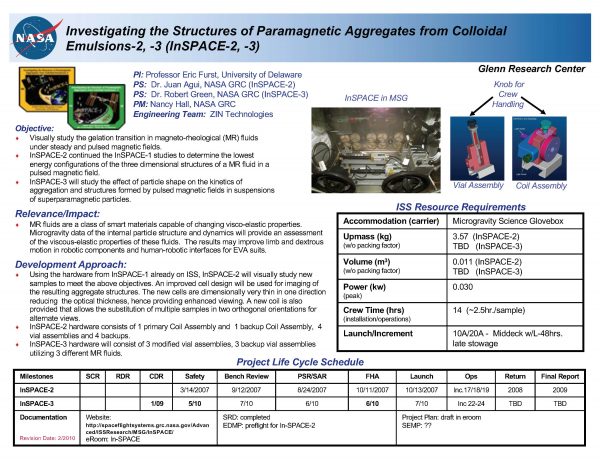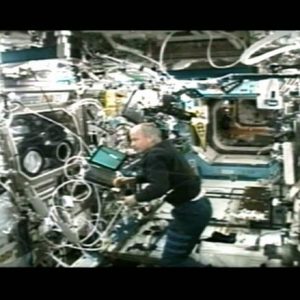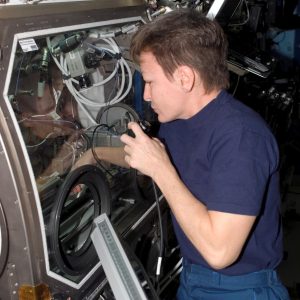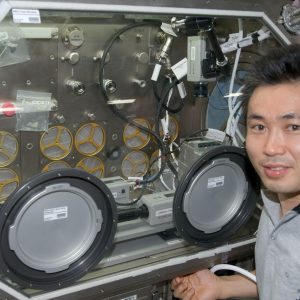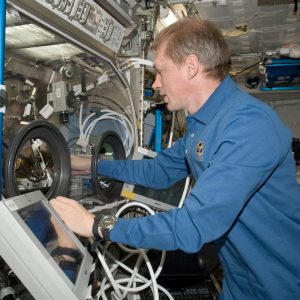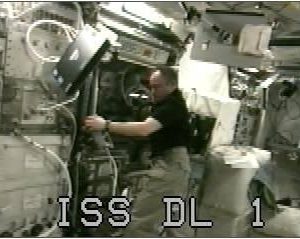InSPACE-2
Investigating the Structure of Paramagnetic Aggregates from Colloidal Emulsion-2
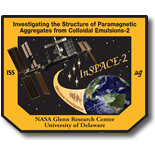
Investigating the Structure of Paramagnetic Aggregates from Colloidal Emulsion – 2 investigation is a continuation of the InSPACE investigation begun on ISS Expedition 6, providing new and improved samples for operation in the Microgravity Science Glovebox (MSG).
Magnetorheological (MR) fluids are suspensions of paramagnetic particles that can quickly solidify when exposed to a magnetic field and return to their original liquid state when the magnetic field is removed. This solidification process produces viscoelastic properties that can be harnessed for a variety of mechanical devices from intricate robotic motions to strong braking and clutch mechanisms.
Understanding how to precisely control these properties and states will enable the use of MR fluids as a working fluid in exploration robots to produce a range of articulated motions ranging from delicate —e.g., picking up an egg —to firm response, and proper encapsulation pressure around bone fractures. Current robotic technology depends on conventional mechanical components like gears, dashpots, and clutches, while MR fluid interfaces provide significantly faster response, strength, tenability, and physical flexibility to enhance human and robotic movement and strength.
Gravitational effects in MR fluids are manifested as variations in particle concentration and phase separation due to particle sedimentation, directly impacting rheological (viscoelastic) properties and application performance. Long-duration microgravity is needed to study the internal structural evolution in the MR fluids in the absence of these additional effects.
InSPACE-2 will provide feasibility data on the gelation transition in MR fluids under steady magnetic fields and perform runs using new samples with an improved cell design for imaging the resulting large aggregate structures, based on previous InSPACE data.
InSPACE-2 hardware consists of two new Helmholtz coil assemblies containing sealed vials of MR fluid and eight new vial assemblies that hold the test fluid. The new hardware will interface with the InSPACE hardware currently on ISS. InSPACE-2 data will significantly impact design of human robotic interfaces for exploration missions.
Science Background and Objectives
Science Objectives
Science Results
Magnetorheological fluids are colloids —fine particles suspended in fluid —that can form solid-like gels when exposed to a steady, uniform magnetic field. This experiment observed two distinct particle growth processes: one where particle-rich and particle-poor regions form, and another where the structure suddenly collapses and particle columns form.
Magnetic field strength and frequency determine which of these two processes occur, and in microgravity, the particular structures can be maintained as long as the magnetic forces are applied. The results suggest how manipulating magnetic fields may be used to harness colloidal suspensions to create unique materials and electro-mechanical devices.
Experiment Operations
InSPACE-2 will be conducted inside the MSG work volume, and the hardware will be powered with 120 volts via MSG. Experiment runs will be recorded by MSG’s video system. Using the optics from InSPACE-1 already on ISS, InSPACE-2 will visually study new samples. An improved cell design over that used in InSPACE-1 will be used for better imaging of the resulting aggregate structures. The new cells are dimensionally very thin in one direction which reduces the optical thickness in that direction and thus provides better viewing.
A new coil is also provided that allows the substitution of multiple samples in two orthogonal orientations for alternate views. InSPACE-2 will provide data on the performance of magnetorheological (MR) fluids in a microgravity environment, under steady and intermittent operation (pulsed fields). InSPACE-2 is not a fully automated payload. The crew will be responsible for in-orbit operations, such as sample changes and video tape changes.
The crew will set up InSPACE inside the MSG work volume and conduct 27 experiment runs using the glove ports. They will change out the coils after nine experiments and replace video tapes as necessary.
Applications
Space Applications
At the practical level, these fluids are used in electromechanical interfaces and devices in which the fluid is operationally exposed to similar fields which can affect their operation. Current commercial MR fluid products include tunable dampers and brakes, while future applications in robotics, clutches, and a host of vibration-control systems are envisioned.
Earth Applications
The study of MR fluids on Earth is difficult because the small magnetic particles remain suspended while the sediments (large particles) sink. The ISS’ low-gravity environment will eliminate the effects of sinking sedimentation. After the magnetic field is applied to an MR fluid, the microstructures form a rigid lattice that causes the suspension to stiffen.
The rapid transformation of these fluids without the iron oxide grains clumping have many possible applications on Earth, especially for actuator-type devices. This technology has potential to improve design structures, such as bridges and buildings, to avoid earthquake damage.
Previous Missions
InSPACE —the precursor to InSPACE-2 —was performed on ISS Expeditions 6, 7, 12 and 13.
Related Documents
Currently updating…
Publications
Journal Papers
-
-
- Biswal, S.L. and Gast, A. P. “Micromixing with linked chains of paramagnetic particles” Analytical Chemistry, 76 (21), 6448-6455, (2004).
- Biswal, S.L. and Gast, A. P. “Rotational dynamics of semiflexible paramagnetic particle chains” Physical Review E, 69 (4), Art No. 041406, Part 1 Apr 2004.
- Lyles, B.F., Terrot, M.S., Hammond, P.T. and Gast, A. P. “Directed patterned adsorption of magnetic beads on polyelectrolyte multilayers on glass” Langmuir, 20 (8), 3028-3031 (2004).
- Biswal, S.L. and Gast, A. P. “Mechanics of semiflexible chains formed bypoly(ethylene glycol)-linked paramagnetc particles” Physical Review E, 68 (2), Art No. 021402, Part 1 Aug 2003.
- Furst, E.M. and Gast, A. P. “Dynamics and lateral interactions of dipolar chains” Physical Review E, 62 (5), 6916-6925 (2000).
- Furst, E.M. and Gast, A. P. “Micromechanics of magnetorheological suspensions ” Physical Review E, 61 (6), 6732-6739 (2000).
- Furst, E. M., and Gast, A. P. “Micromechanics of dipolar chains using optical tweezers” Physical Review Letters, 82 (20), 4130-4133 (1999).
- Furst, E. M., and Gast, A. P. “Particle dynamics in magnetorheological suspensions using diffusing wave spectroscopy,” Physical Review E, 58, 3372 (1998).
- Furst, E. M., Suzuki, C., Fermigier, M., and Gast, A. P.”Permanently-linked monodisperse paramagnetic chains” Langmuir, 14 (26), 7334 -7336 (1998).
- Promislow, J.H.E.; and Gast, A.P., ”Magnetorheological Fluid Structure in a Pulsed Magnetic Field. Langmuir,”, vol. 12, no. 17, 1996, pp. 4095-4102.
- Promislow J.H.E and.Gast, A.P, “Low-Energy Suspension Structure of a Magnetorheological Fluid,” Phys.Rev. E 56 (1997) 642:651.
- Promislow, J.H.E, Gast, A.P. and Fermigier, M., “Aggregation Kinetics of Paramagnetic Colloidal Particles.” J.Chem. Phys. 102 (1995) 5492:5498.
-
Conference Presentations
-
-
- P.A. Vasquez, J. Agui, and E. M. Furst “Structural Transitions of MR Fluids in Microgravity,” Poster presentation, 79th Society of Rheology meeting, October 7-11, 2007, Salt Lake City, UT.
- A. Gast, B. Lyles, K. Bentley, J. Agui, and D. Pettit. “Magnetic Emulsions in Space”. Symposium in Honor of Darsh Wasan I: Interfacial and Colloidal Phenomena. AIChE annual meeting, November 16-21, 2003, San Francisco, CA.
-
Gallery
Contact Information
Principal Investigator: Professor Eric Furst, University of Delaware
Project Scientist: Dr. Juan Agui, NASA GRC (InSPACE-2)
Project Manager: Nancy Hall, NASA GRC
Engineering team: ZIN Technologies

